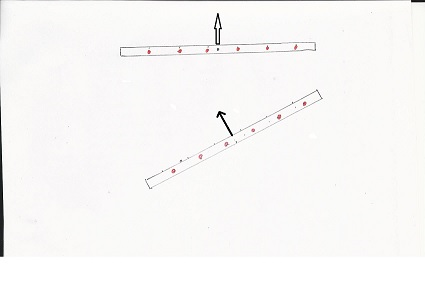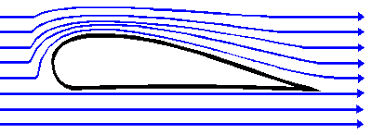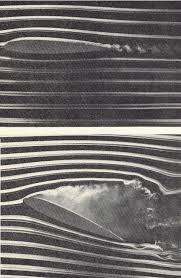-
Posts
5,297 -
Joined
-
Last visited
-
Days Won
78
Content Type
Profiles
Forums
Gallery
Downloads
Blogs
Events
Store
Aircraft
Resources
Tutorials
Articles
Classifieds
Movies
Books
Community Map
Quizzes
Videos Directory
Everything posted by old man emu
-
And that's been the problem all along. You don't read anything and are able understand it. Then you go and pick the nits out of it and twist them around in order to antagonise. I have been saying that mass refers to the number of molecules, while weight refers to the force that mass would exert if it was accelerated at ~ 10 m/s/s. In introducing those pictures I was illustrating that The markings on the scale reflect the use to which the spring scale is to be put, and I said that plain and clear. A scale marked in kilograms could be found in everyman's fishing tackle box, but a scale marked in newtons is likely only to be found in a physics classroom. There is only one crime that I abhor, and that is lying. I can forgive any other crime from littering to murder, but I can't forgive lying. So if we ever met, face-to-face, the next thing you would see is my back. What's the point, you wouldn't read any part of the discussion to understand what is being said. I'm not the one sitting under a bridge waiting for the Billy Goats Gruff.
-
I fear that this topic has become an Oozlum bird. It would be churlish of me to use my Moderator's authority to lock this thread, so another moderator might like to. In all good faith I can't see this discussion reaching agreement. The only consensus that I can see is that we agree to disagree.
-
I can tell you that according to the scientists working in the area of chemistry, one litre of water contains 55.55 mols of water, therefore contains 55.55 x 6.02214076 × 1023. water molecules ( mols x Avogadro's Number). In Norse mythology, Gram (Old Norse Gramr, meaning "Wrath") is the sword that Sigurd used to kill the dragon Fafnir. It is primarily used by the Volsungs in the Volsunga Saga. Nowhere in the Volsunga Saga is a clear description of Gram given. And I can't find a satisfactory definition of "gram" in the places I can find a definition of "second" and "metre". Currently the kilogram is defined as 6.62607015 × 10−34 joule x second. The joule (symbol: J) is a derived unit of energy in the International System of Units. It is equal to the work done on an object when a force of one newton acts on that object in the direction of the force's motion through a distance of one metre. The units that the joule is derived from are: As an aside, if you multiply joules by seconds, as the this 6.62607015 × 10−34 joule x second says to do them you get kg x velocity, which is momentum. The problem that I have is that the kilogram is being defined by itself.
-
Obsolete in the eyes of the SI unit system, but for distance and mass the units are simply 1/1000th of those of the SI system. Measuring scales that tell us the "weight" of an object are actually scales that tell us the force required to stop the object from falling further towards the Earth. They measure the equal and opposite force to the force of gravity. If their indicator scales were marked in SI units, they would show this force in Newtons. In 1948, the 9th Conférence Générale des Poids et Mesures (CGPM) Resolution 7 adopted the name Newton for this force. Thus the word "Newton" in this usage is new to the vocabulary. Since it is a new term, it is not likely to displace each language's word for "weight" in the vernacular. So scales continued to be marked with the words kilogram or pound, depending on the local common term. When we talk about the weight of an aircraft, we are talking about the number of Newtons of force it applies to a measuring device.
-
Yes and Yes. For the last time. "weight" is something that matter has if it is influenced by the gravitational attraction of another bit of matter. We use that word in our day-to-day lives to refer to the resultant force caused by the effect of the gravitational attraction of the Earth. In round figures that resultant force is found by multiplying the amount of mass by approximately 10. Mass is simply the number of atoms that compose the sample of matter. Think of mass as the number of bricks in a wall. This picture shows a spring scale. The face is divided with marks that indicate how far the the spring has been stretched. The distance stretched is related to the resultant force which is equal to the product of the mass and acceleration due to gravity is applied to the spring. The markings on the scale reflect the use to which the spring scale is to be put. This scale is used to tell the "weight" of objects. This scale is used to show the number of Newtons of Force applied to the spring.
-
Exactly. By George, he's got it! He's really got it! Does this affect our calculations? Not really if at the beginning you specify the units you want to work with. If you see the MTOW quoted as 600 kgs, you know that you are going to be talking in units of in the centimetre-gram-second (CGS system) and you are referring to a unit called kilogram-weight which is mass x acceleration due to gravity. If you quote it as 60 kg mass, you are working in the International System of Units (SI) (metre-kilogram second), and ignoring the acceleration due to gravity. Since Mankind began comparing the amount of things by weighing, it has used values that are really a comparison the the force of Gravity. So our cultures have named certain amounts of force as by many names, https://en.wikipedia.org/wiki/List_of_obsolete_units_of_measurement. In every field except the basic sciences, a word that describes the heaviness if something is really relating the force it exerts due to the acceleration due to gravity. The etymology of the word "weigh" is Old English wegan (class V strong verb, past tense wæg, past participle wægon) "find the weight of, measure; have weight; lift, carry, support, sustain, bear; move," from Proto-Germanic *wegan (source also of Old Saxon wegan, Old Frisian wega, Dutch wegen "to weigh;" Old Norse vega, Old High German wegan "to move, carry, weigh;" German wiegen "to weigh," bewegen "to move, stir"), from PIE root *wegh- "to go, move, transport in a vehicle." And "wagon" is from the same source. It's pretty obvious that if you tell a non-physicist that your plane has a mass of 60 kgs, they will imagine that you are flying something like the Gossamer Albatross.
-
Yes. But you keep seeming to dispute that. There must be some words that are causing confusion because the maths is correct. Please indicate what is confusing you. Correct. Mrs Einstein told Albert to go an buy her three kilograms of potatoes for her cooking. Albert came back with a quantity of potatoes that Mrs Einstein recognised as about right for her version of three kilograms of potatoes. Albert said, 'There you are my Love, 300 grams of potato matter'.
-
What's the point of posting links to explanations given by people other than myself when the enquirer obviously won't follow them?
-
Sorry that I didn't jump to reply to your demand for a reply, but I've wasted too much time trying to show someone who has no understanding of the manipulation of algebraic equations and a complete lack of primary school arithmetic ability to know that three divided by ten is the decimal fraction 0.3 . How you are ever going to be able to do the simple calculations required for aerial navigation has me stumped.
-
And the materials and structure of the desk are able to exert a force of 10 N as an equal an opposite force. Try putting 1000 kg on the desk and see if the 1000 kg accelerates downwards.
-
" it turns out that the only thing that you were interested in was that sine 45 = 0.7." When and where did I ever indicate that I did happen to use a value of 45 degrees to illustrate a position of a wing relative to the longitudinal axis of an aircraft, or to indicate an angle relative to the longitudinal axis of a wind tunnel that an aerofoil could be placed? I repeatedly said that my point was not related to anything more than that all the diagrams we are shown about how the Lift force produced by an aerofoil can confuse when you consider diagramming the Lift produced by an aerofoil from plan view as it is placed at different angles to the air stream coming at it. It was other people who wandered off talking about what happens when the aerofoil is attached to a fuselage and taken into the air to bank and roll and loop. And we can have perpetual motion machines and free energy. When the box is on the floor there is a mechanical interaction between the floor and the surface of the box that is in contact with it because both surfaces are not absolutely smooth even to the molecular level. This mechanical interaction prevent the two surfaces moving against one another and is called Friction. In order to slide the box, that Friction force has to be overcome. Say you want to move the box from left to right. You apply a Force to the left side of the box, so you create a Force vector acting from left to right. In accordance with Newton's Third Law, the mechanical interaction creates a force vector acting from right to left. Since at all times the force on the box arising from the acceleration due to gravity is the same, we can recognise it mathematically by assigning a value of one unit of force to it. Therefore, to move the box we have to apply a Force to the left side that will overcome the Friction force acting to the right. I've spent too much time trying to explain this, so you can do your own research and read this: https://x-engineer.org/undergraduate-engineering/physics/solid-mechanics/how-to-calculate-friction-force/ An African forest elephant has a weight of 25,000 N What is the mass of the African forest elephant? Weight is another word for the force of gravity mg. We can solve for the mass using the formula W=Fg=mg. (use the formula for weight) 25,000 N=m(9.8 s2 m)(plug in values for weight and g) m=25,000 N/(9.8 m s^-2)(solve for mass m) m= 2,551 kg https://www.khanacademy.org/science/high-school-physics/forces-and-newtons-laws-of-motion/newtons-first-law-mass-and-inertia/a/what-is-weight And if you don't believe that, ask Jabiru7252. He understands. I bet you can't explain that statement
-
Too true. The big problem is that we really cannot work out the mass of an atom so that we can multiply that number by The Avogadro constant which is the proportionality factor that relates the number of constituent particles (usually molecules, atoms or ions) in a sample with the amount of substance in that sample. The numeric value of the Avogadro constant expressed in reciprocal mole, a dimensionless number, is called the Avogadro number, which is exactly 6.02214076×10^23 is thus the number of particles that are contained in one mole (not one of these). The mole (symbol: mol) is the unit of measurement for amount of substance in the International System of Units (SI). It is defined as exactly 6.02214076×1023 particles. The trouble is that, for example, one mole of water contains 6.02214076×1023 molecules, whose total mass is about 18.015 grams. Notice the circular argument? The mass of 1 mole of a substance is equal to its relative atomic or molecular mass in grams. The relative atomic number is related to Carbon, whose atomic number is 6 and atomic weight is 12. You could work out the mass of an atom of carbon by the use of Einstein's equation, but that a real lot of energy since C^2 is a massive number.
-
aro, I am crying tears of blood. You keep saying that I know f-all about physics. I cry because you know f-nothing. In physics, a force is any interaction that, when unopposed, will change the motion of an object. A force can cause an object with mass to change its velocity (which includes to begin moving from a state of rest), i.e., to accelerate. Force can also be described intuitively as a push or a pull. A force has both magnitude and direction, making it a vector quantity. It is measured in the SI unit of newtons and represented by the symbol F. Characteristics of Force: Forces are due to an interaction of at least two objects. It may change the state of motion of an object. It may change the shape of an object. The very definition of Force involves a change in velocity over time (acceleration) F = m.a Force is proportional to acceleration, which is defined as the rate of change of velocity. It is also proportional to mass for a particular acceleration, but we don't usually talk about varying the mass, except if we are talking about stall speeds at different amount of load a plane is carrying, but let's not go there right now. Work is the energy transferred to or from an object via the application of force along a displacement. Work is a scalar quantity, so it has only magnitude and no direction. Work transfers energy from one place to another, or one form to another. The SI unit of work is the joule (J), the same unit as for energy. To calculate the amount of work done we use the equation W = Force . distance (W = F.d = m.a.d) The units of Work are Joules which have the dimensions which is the result of multiplying mass by acceleration by distance In your example of a box being pushed across the floor, consider Newton's Third Law - equal and opposite forces. If you want to move the box in a certain direction, you apply a force to it. Because of the surface of the box and the floor are not perfectly smooth (an impossible situation, ever an molecular level) they lock together. To get the box moving you have to overcome that mechanical interlocking. That resistance to movement due to mechanical interference is called Friction, which is a Force acting in the opposite direction to the desired direction of movement. The level of friction that different materials exhibit is measured by the coefficient of friction. The formula is µ = f / N, where µ is the coefficient of friction, f is the amount of force that resists motion, and N is the normal force, or force acting at right angles to the desired direction of motion. In this case, it is the force of gravity. Moving the box involves exerting a Force that is equal to Force to overcome the Friction force. Once that force has been overcome, the box will move and Work will be done. To keep the box moving you have to apply a force that is greater that Friction force. Since the force due to gravity never changes while you are applying the force to overcome Friction, you can assign it a value of 1 in calculations and add the real value in at the end of the calculations. Perhaps this diagram will help.
-
Using the hesitation roll was a bad choice of illustration. What I really wanted to show was a wing generating lift at an angle the average pilot rarely goes to. I admit it screwed up what I was intending to discuss. This is where the fight begins. Sorry, but this is going to involve some definitions. I think we agree that the magnitude of a force is the result of the acceleration of a mass, which we can calculate using the equation F = m.a The biggest problem in understanding this is getting our heads around what exactly is a kilogram. The kilogram, symbol kg, is the SI unit of mass. It is defined by taking the fixed numerical value of the Planck constant h to be 6.626 070 15 × 10^-34 when expressed in the unit Joules times s seconds, which is equal to kg m2 s -1 , where the metre and the second are defined in terms of c, speed of light and ∆νCs,( radiation produced by the transition between the two hyperfine ground states of caesium (in the absence of external influences such as the Earth's magnetic field) has a frequency, ΔνCs, of exactly 9192631770 Hz.) I don't know about you, but I can't visualise that as a ball of matter. Let's look at something tangible. Suppose we had a box of a dozen golf balls. They are manufactured to a standard, so we can assume that each one has the same amount of matter in it as the others. That represents the "m" in the equation. If I take a spring balance and cover the inscribed scale with masking tape, I have a device that that obeys Hooke's Law - the force (F) needed to extend or compress a spring by some distance (x) scales linearly with respect to that distance. If I connect the box of golf balls to the spring balance, the spring will stretch and I can mark the position of the pointer that indicates the length the spring has stretched on the masking tape. Let's say that we apply Hooke's law by taking the length of stretch of the spring and working out the force required to stretch the spring that far and plug that value into our original Force equation. For the sake of the discussion, let's say that the value of the force was 14 Newtons, and we know that the acceleration due to gravity where we did the weighing was 9.81 m/s/s. The units of mass are kilograms because we are working in Newtons. So we have F = m.a 14 = m. 9.81 Dividing both sides by 9.91 14/9.81 = m 1.427 kg = m So the force registered by a scale is not really a measure of the amount of matter being weighed. The weight of an average adult exerts a force of about 608 N. 608 N = 62 kg × 9.80665 m/s2 (where 62 kg is the world average adult mass) So, to finally answer your question, a one kilogram-weight is the force resulting from the from the acceleration of (1 divided by 9.81) kilograms of matter due to the Earths gravitational attraction acting on the mass. 1 divided by 9.81 = 0.102 kg of matter. If you go to the greengrocer to buy a 1 kg mass of potatoes, his scale will be marked off with symbols that say kilograms, but you know that in reality, when he puts your potatoes into the weighing pan, the spring in the scale will stretch is response to the application of 9.81 Newtons of force. Scales show Kilograms because that is what people understand best, but it is really just an estimate of the mass above them. Scales should really show Newtons, but that might confuse people! Thanks for coming. I'm here 'til Thursday. Try the veal.
-
Yes we could. Since Lift is a vector, it has direction. The name we have given to the force is "Lift", so that is the term we should use. It gains its "direction" from the angle between the direction it acts and the vertical extension of the direction of action of the weight force of the aircraft. We say that the value of the Lift force vector upwards is positive. Yep. That's because, relative to the horizontal axis, the Lift force would be acting at either zero or 180 degrees relative to the horizontal axis and the magnitude of the Lift force in the horizontal axis is Lift x sin 0, or of Lift x Sin 180, which are both zero.
-
Actually I don't give a tinker's cuss whether it's a banquet, a roll or a bloody pizza. I'm not interested at all in what happens when and aerofoil is attached to box. I am going right back to the basic generation of a Lift force due to the movement of an airmass across a modified plate. If you want to drift the topic into what happens when a machine applying the principle of aerodynamic Lift operates in practice, please start your own thread. I will follow it with great interest. WHAT I WANTED TO SAY WAS THAT THE COMMON DIAGRAMS AND PICTURES WE USE TO UNDERSTAND LIFT FORCE GENERATION ARE ALWAYS SIDE ELEVATIONS OF THE AEROFOIL. THIS IMAGE IS IMPLANTED IN OUR MIND'S KNOWLEDGE CACHE, SO THAT WHEN WE TRY TO UNDERSTAND THE CONCEPT OF RELATIVE AIRFLOW IN RELATION TO THE WING IN PLAN VIEW, THE IMAGE IN OUR MENTAL CACHE COMES OUT AND CONFUSES US. AGREED, but it was the quickest way I could find to illustrate the directions of the force vectors. As for an aerofoil not producing any Lift force when at 90 degrees to the horizontal - look at the tail fin of an aircraft. Air moves across each side, which have the same shape on both sides. Therefore the aerodynamic Lift force must be equal on both sides, each side cancelling the other. It is only when the camber is changed by the movement of the rudder that these forces go out of balance and a desired result is achieved.
-

What can be done about shrinking airports?
old man emu replied to planedriver's topic in AUS/NZ General Discussion
I believe that the training area, which could be used by both Camden and The Oaks will be south of Burragorang Road and west of the Hume Hwy down to about Tahmoor. I can see a lot of fixed wing training moving out of Bankstown to Camden, but that depends on the infrastructure support that Sydney Metro Airports gives to Camden. The Oaks airfield is on a flood plain and after the recent flood along the Nepean/Hawkesbury system I can't see the local council approving any residential or industrial building on it. -
This is one of those diagrams that I say is causing confusion: While this is a totally correct way to explain why the pilot has to take action to increase the resultant lift in order to complete the desired manoeuvre, it does not illustrate how the relative airflow moves around the wing. Here is a scrappy diagram of what I am getting at. The rectangles represent the leading edge of a flat plate. The red dots represent the airflow meeting the leading edge, and you can assume that the air diverts over and under the wing as we know it does. In order to get a bit more Lift force we'll arbitrarily assign an AoA of 4 degrees. I don't have the CAD software to draw that in a diagram. Imagine that the plate is connected to some device that measures the magnitude of the Lift force, and that device allows us to tilt the plate around the halfway point of the span. I have drawn the lower rectangle with a 20 degree tilt down with respect to the top one - simply to fit the diagram on a page. Now if we pass an airstream (relative airflow), having a known velocity and density of the air, at the top rectangular plate, a Lift force will be generated, which we can depict as an arrow pointing upwards. Our measuring device can tell us the magnitude of that force. Next, without changing AoA , airflow velocity or air density, we tilt the plate away from the horizontal and again obtain a value for the magnitude of the Lift force. The two magnitudes will be the same. In other words, the angle of the plate relative to the horizontal datum will not affect the magnitude of Lift force generated by the plate. This is because no matter how the plate is orientated in relation to the horizontal datum the density and velocity of the relative airflow are the same. The plate is immersed in the fluid the same way that a fish is immersed in the sea. It is incredibly hard to produce a two-dimensional diagram of this, that's why I said to use a three-dimensional object to help envisage what I am saying. If this plate was set up at 90 degrees to the horizontal datum, would the Lift force be the same as in the other two cases? Yes, but when one wants to use that Lift force to balance the weight force of an aircraft, there is no vector component that is equal and opposite to the weight force. aro mentioned at one point that the horizontal vector of the Total Lift force is used to turn the aircraft. When the wing is at 90 degrees vertical, one would guess that it's all turn and no holding altitude. Phew!
-
How can it be at various angles to the airflow and still be at the same AOA? It makes sense if you put a modicum of thought into the set up of the experiment. Here's how you can visualise the set up. Pick up a ruler, say a normal 30 cm one. Hold it in front of your eyes so that the long lateral axis of the ruler is horizontal from right to left, and the short, longitudinal axis is level with your eyes, so that you can only see the thin edge of the ruler. Now hold it there with your finger at the 15 cm mark. This is what we will call the "normal" angle of the ruler to air blowing at your face from the front. The deflection of the airflow across a flat plate will produce an amount of Lift force. We need to generate some Lift force for this experiment, so we will set the angle between the airflow and the longitudinal axis to an arbitrary 4 degrees. With the ruler set up thusly, we blow a steady airflow at the ruler. This airflow separates at the edge of the ruler and some goes over and some under the ruler generating a Lift force, which our incredibly accurate measuring devices can detect and display. Now, without altering the angle between the airflow and the longitudinal axis which is arbitrary 4 degrees, drop one end of the ruler so that it is 10 degrees below the original horizontal. We haven't change any other factor. Because the ruler is immersed in the air, it will produce a Lift force. That magnitude of Lift force will be the same as when the Lift force was measured initially. Are we ignoring the Total reaction on the aerofoil? Wind tunnels have no weight and no thrust so the TR will be different. Yes, because we are not trying to balance any other force. All we are trying to find out is what the magnitude of the force is when air flows over the ruler, which is representing a wing. In practice, a designer knows that this experiment will give the Total Expected Lift force of a wing, as well as knowing that this Total will be eroded by all the factors that people have mentioned. Having taken all those things into account, the designer can determine the MTOW of the aircraft being designed. You said changing the angle to the airflow changes the AOA that's the very definition of AOA? What I am trying to get you to think about is "What diagram or picture have you seen that helps you visualise the airflow in this situation? I'm saying that these have caused you confusion because the don't show the airflow from the plan view of the wing. What I am saying is that one should be careful about which illustrations they plant in their mind to help understand concepts.
-
For Sod's sake, will you forget about what Pontius Pilate is doing in the aircraft and go back to basics. A section of wing in a constant airflow device with measuring devices to measure the Lift force when the wing is at various angles to the direction of the Earth's gravitational force. Will you discuss the proposition that sometimes the diagrams we use to illustrate one point can confuse the understanding of other propositions?
-
This is what you said, "Can't wait for your correct answer. In the real world the lift produced will depend on the angle of attack and airspeed, both pilot controlled. Angle of bank is irrelevant" Can you see now that this is NOT what I was getting at? I'm not denying that what you say is true. All I wanted was an answer that compared the Lift force generated by a wing that had been rotated at an angle to the direction of the Earth's gravitational force with the Lift force generated when the wing was at 90 degrees to that gravitational force.
-
See John 11:35 I don't give a rat's arse about the further effect of the vertical and the lateral components of the Lift vector. I acknowledge every thing that you are saying about the further effects is correct. Will you acknowledge that 1. The Lift vector acts at 90 degrees to the direction of the airflow. 2. If the air in the vicinity of the wing, and here let's arbitrarily call "vicinity" anything within a sphere whose radius if which is (1/2 wingspan) + 5 metres, has consistent density then the lift generated by the wing is not dependant on the angle of the wing, or if you like, chord line, relative to the the direction of the gravitational force of the Earth. 3. If a section of wing, say 1 metre long, was to be placed in a wind tunnel, so that it could be held stationary at various angles to the airflow, with the AoA constant, the Lift force generated by the section would be the same for all angles that it was held at. 4. That when trying to grasp a new concept, we rely on our prior knowledge and experience to apply the old to the new. Therefore, if a person's old knowledge and experience has involved seeing diagrams where the wing is depicted in side elevation, then that can be a hindrance when considering a different situation where the wing is depicted in plan view. Nev, my big mistake is thinking that people can "think outside the box". In other words look at a situation from a different stance. What I see here is people not stopping to think more deeply. They have given replies (those that are not derogatory) that of themselves are quite correct, but show that they are not thinking deeply about what is proposed. That's why there has been all this stuff about rolling and banking and such. Those replies go further than the proposition raised. That's why I was careful to use the word "instantaneous" and to say that an infinitesimal time after a plane's wing reaches a nominated angle, the pilot has to work to maintain direction and altitude. I agree that as soon as the rotation of the wing starts, the Lift/Gravity pair goes out of balance, but in real life, as shown in the video, getting to 45 degrees is pretty quick, and the pilot wouldn't start acting to ensure that direction and altitude were maintained until the desired angle was reached - remember reaction time of the pilot, even one who knows what is going to happen and what has to be done.












